VIRO M1 | History of Virology, Nature & Origin of Viruses
1/119
There's no tags or description
Looks like no tags are added yet.
Name | Mastery | Learn | Test | Matching | Spaced |
|---|
No study sessions yet.
120 Terms
T/F: Everyone is infected with viruses all the time
TRUE
Viruses are part of our microbiome
Why do we study viruses?
Primarily because they are agents of disease and could have worldwide consequences, trickling down to societal issues
T/F: There were no historical records of viral diseases before viruses were identified
FALSE
There are a lot of historical records of viral diseases before viruses were even identified
Enumerate 3 examples of historical records proving existence of viral diseases even before viruses were even identified
Temple Priest Sipta 1400 BC
Hieroglyph portraying withered leg of Priest Sipta, most likely Poliovirus
Pharaoh Ramses V 1196 BC
Pustules on face, resembling small pox (DNA identified)
Inca emperor Atahuallpa and Spaniard Francisco Pizzaro 1532
Small pox lead to the downfall of many civilizations, e.g., Central and South America. When Spaniards and Portuguese went to America, they spread small pox in those civilizations that have never contracted the disease before and thus have no immunity to it, contributing to the success of the said civilization in colonizing those countries

There is _ HIV-1 genomes existing on this planet, and it is highly probably that there exists a genome which encodes resistance to each one of the antiviral drugs available
106 (1 million)
Describe HIV & AIDS surveillance in Ph from Jul-Sep 2024
Average no. of cases per day =
No. of males infected =
No. of females infected =
Jan. 1984 - Sep. 2024 (total) =
Newly reported cases =
Advanced HIV cases =
Age group with highest incidence =
Region with highest incidence =
Average no. of cases per day = 50
No. of males infected = 4K
No. of females infected = 200+
Jan. 1984 - Sep. 2024 (total) = 139K
Newly reported cases = 4K
Advanced HIV cases = 1K
Age group with highest incidence = 25-34 yo (47%)
Region with highest incidence = NCR
Type of genome HIV has
RNA
T/F: DNA genomes evolve more quickly than RNA genomes
FALSE
RNA genomes evolve more quickly than DNA genomes bc there is no proofreading and editing
Vector-borne tropical diseases, e.g., Zika, Dengue, Chikungunya, are now spreading to the northern and southern hemispheres due to _
climate change (global warming)

Over the past decade, _ has made its way home at increasingly higher latitudes, partly due to climate change
Aedes albopictus (Asian tiger mosquito)
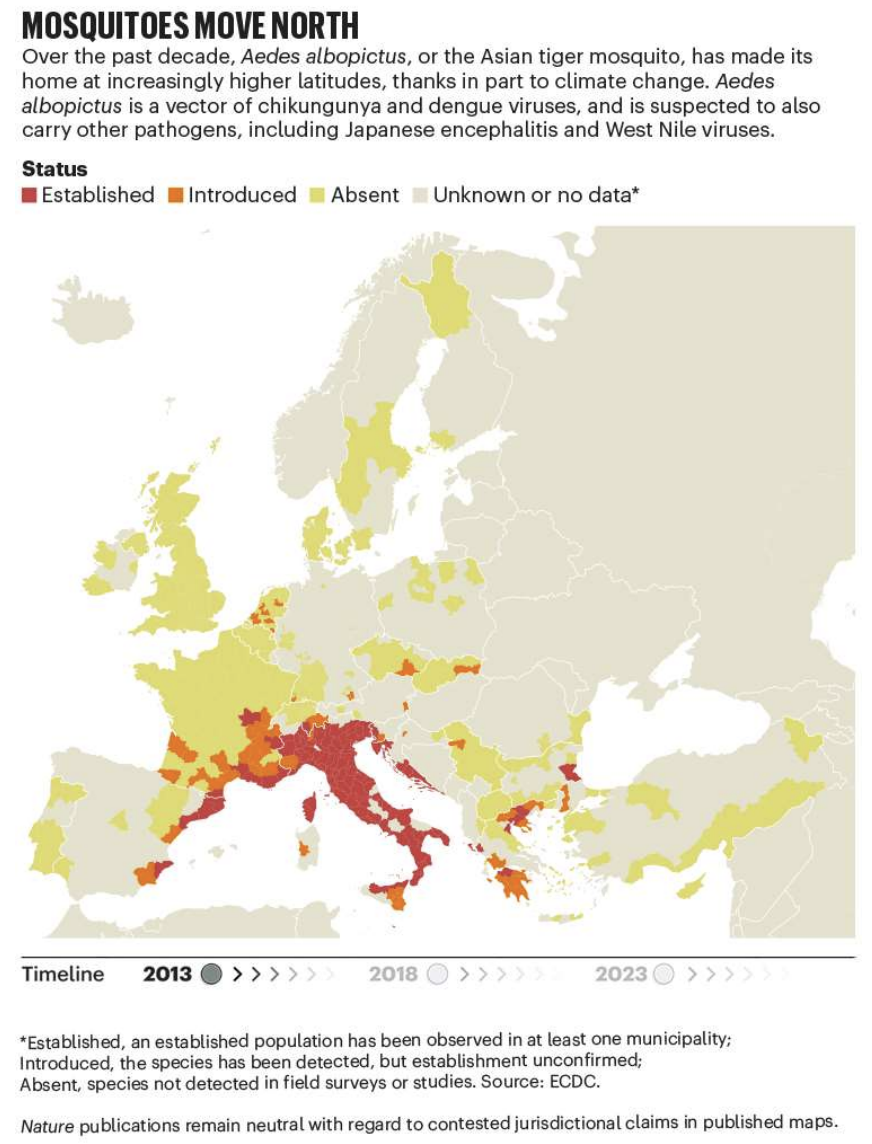
_ is the vector of chikungunya and dengue viruses and is also suspected to carry other pathogens, including Japanese encephalitis and West Nile viruses
Aedes albopictus
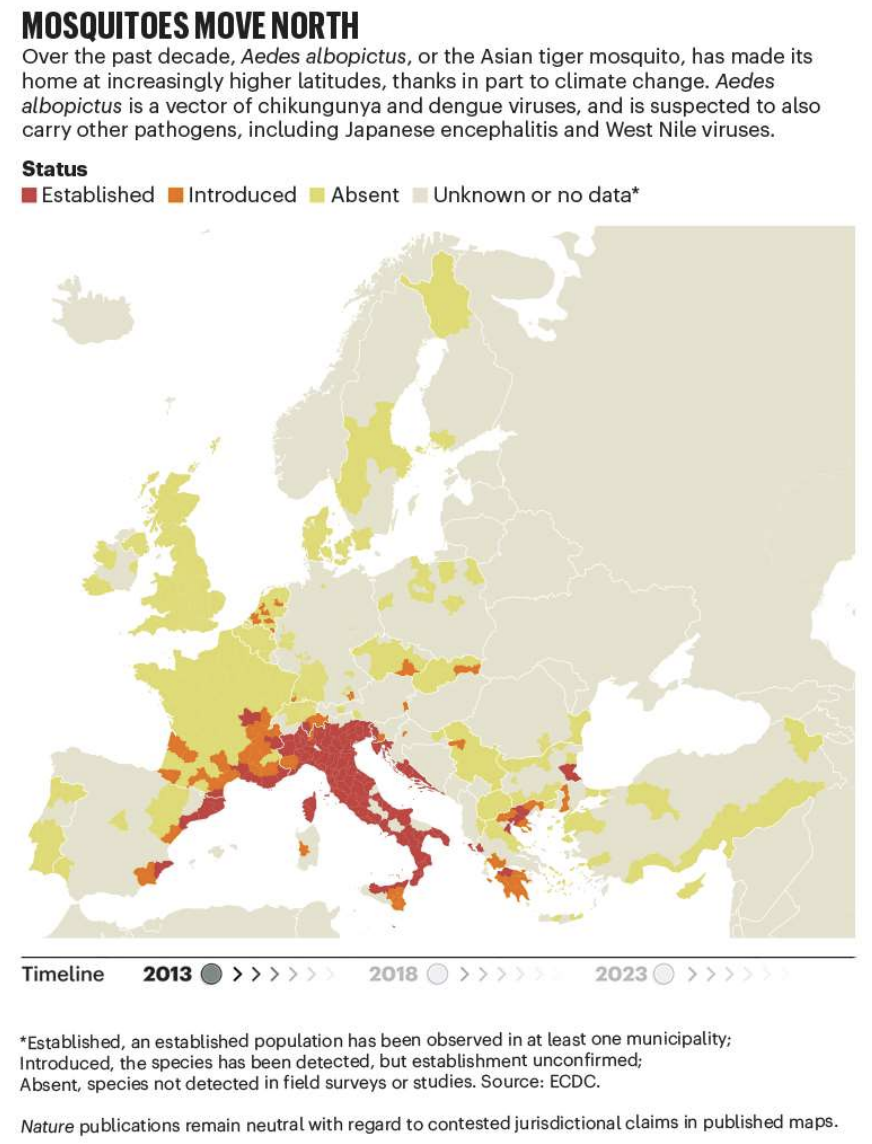
Explain how people tried to control viral disease earlier in history
2-3% of individuals receiving variolation ended up dying from from small pox
The only reason variolation practice continued was because the chance of dying from small pox caught “naturally” from another infected person was higher, i.e., 15-20%
Lady Mary Wortley Montagu introduced practice of variolation from Turkey to political elites back in Europe
_ is hailed one of the greatest scientific discoveries that contributed to the longevity of human life
Vaccination
_ is an early immunization method against small pox involving deliberately introducing material from small pox sores from an infected person to a healthy individual, usually by inhalation or inserting it into a small cut in the skin
Variolation
Who started a more modern protocol for vaccination in 1796?
Edward Jenner
Explain Edward Jenner’s more modern approach to vaccination in 1796
Jenner took material from cowpox sore in milkmaid’s hand and inoculated it to an 8-yr old kid, Phipps
After Phipps recovered from mild cowpox, Jenner then exposed the kid to smallpox, and he did not develop the disease
Conclusion: Exposure to cowpox conferred immunity to smallpox, proving effectiveness of vaccination (“vacca” = cow)
Small pox vaccine is delivered via _
multiple punctures using special 2-pronged needle (inset) dipped in the vaccine
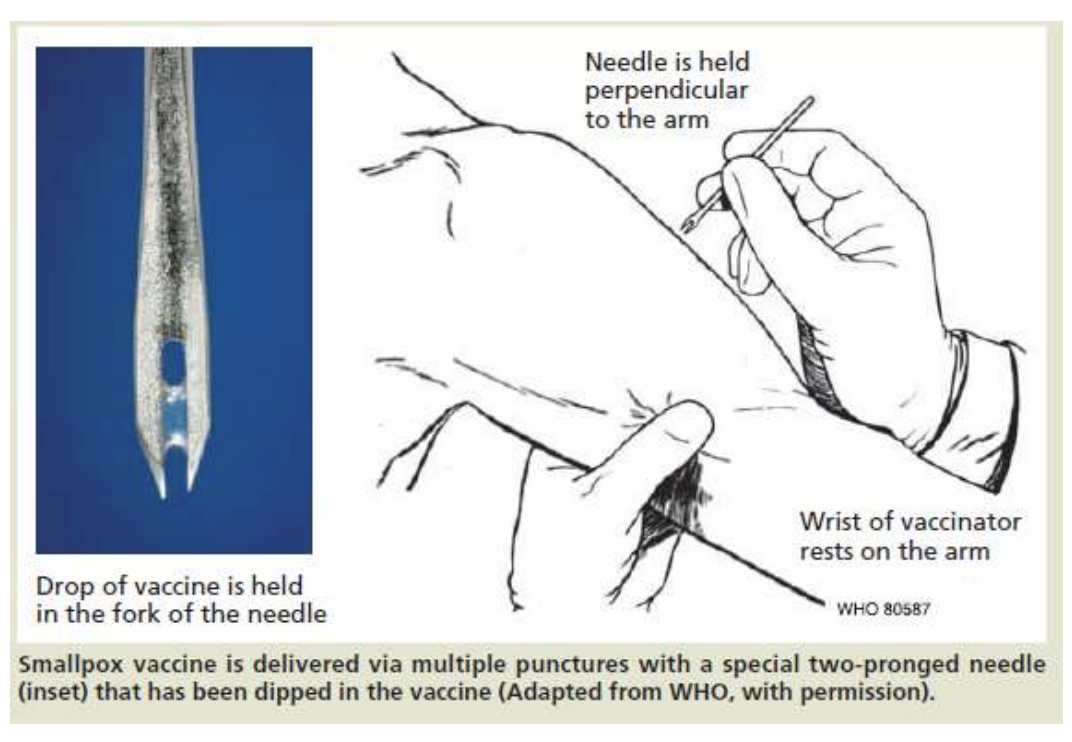
Describe administration of small pox vaccine
Drop of vaccine is held in the fork of the needle
Needle is held perpendicular to the arm
Wrist of vaccinator rests on the arm of person to be vaccinated

_ is the very first disease eradicated worldwide by vaccination in 1980
Small pox
_ are the only people left vaccinated with small pox
Military since there still stands a possibility that small pox virus may be used for bioterrorism
_ lead to the downfall of many civilizations, including Central and South Americas, because when the Spaniards and Portuguese (i.e., Inca emperor Atahuallpa, Spaniard Francisco Pizzaro 1532) went to the America, they spread small pox virus to civilizations who never contracted the disease before and thus have no immunity against it. Hence, this viruses is considered to contribute to their success in colonizing those countries.
Small pox virus

Poliovirus was also on its way on being eradicated, but there was a reemergence around _ (year)
2017-2019
Poliovirus outbreak in 2017-2019 were preceded by early childhood diseases, including _
mmr
Measles
Mumps
Rubella
The largest outbreak in the WHO Western Pacific region occurred in the Philippines, where _ in 2018
Reported cases of measles from
2017 =
2018 =
2019 =
first-dose measle-containing virus (MVC1) coverage had reduced to 75%
Reported cases of measles from
2017 = 2K
2018 = 20K
2019 = 48K
There was a dramatic drop in public confidence after the Philippine dengue vaccine controversy in 2018, with _% people strong agreeing that vaccines are important in 2015 to only _% by 2018
93% strongly agree in 2015
32% strongly agree in 2018 (drop due to dengvaxia crisis)
In Feb. 2018, DOH reported that only around _% of children across the country got their scheduled vaccines, lower than their 85% target
60%
From Jan. 1 to Aug. 25, 2018, MMR cases were _% higher than the number of cases reported during the same period in 2017
419%
_ % of individuals receiving variolation ended up dying from small pox, but variolation practice continued because the chances of dying from small pox caught “naturally” from another person was higher, i.e., _ %
2-3 %
15-20%
_ introduced practice of variolation from Turkey to political elites back in Europe
Lady Mary Wortley Montagu
A series of nationwide surveys shows that Filipinos are hesitant to receive COVID19 vaccines, with almost _ of Filipinos not willing or unsure whether they should be vaccinates.
*The level of hesitancy is higher in Ph compared w/ other countries in the region
half
Enumerate factors cited as reasons for hesitancy on getting vaccinated (2015-2019)
Lack of information about vaccines
Misinformation about their efficacy / side effects
Mistrust
Underestimation of their benefits and overestimation of their risks
Survey results show that highlighting _ of vaccination had a signficant impact on reducing vaccine hesitancy and increasing vaccine acceptance by almost 15%
This suggests that communication campaigns highlighting the potential benefits of _ by emphasizing the prospect of holding family gatherings again and protecting families can significantly reduce vaccine hesitancy in the country
personal and social benefits
herd immunity and vaccines
Although African swine fever (ASF) doesn’t harm humans, outbreaks have caused significant economic losses in various countries, including the Philippines, where a 2019 outbreak lead to the culling of _
Pork production decreased by _ in 2021, leading to higher pork prices and affecting livelihoods of many consumers
300,000 pigs
20.8%

_ is very important when it comes to viral diseases such as avian influenza
Surveillance in areas where there’s congregation of migratory birds in close contact to domesticated animals, e.g., duck farms
Example of viral disease affecting both domesticated animals and humans
Foot and mouth disease
How did Avian flu enter Philippines?
Through smuggled poultry
Over 60% of all emerging infectious diseases worldwide are of _ origin
zoonotic (spread by animals)


T/F: Over time, the broken tulips virus causes bulb to weaken and thus inhibits proper reproduction
TRUE
With each new generation, the bulb grows weaker and weaker, until it has no strength left to flower and withers away
T/F: All viruses cause disease
FALSE
Not all viruses cause disease, though it is easier to study disease-causing viruses bc there is an outward signal of infection
T/F: Viruses are everywhere and infect all cellular life forms
TRUE
_ are by far the most abundant biological entities in the ocean, comprising approximately 94% of the nucleic-acid-containing particles, but because of their small size, they only comprise ~5% of the biomass
Viruses
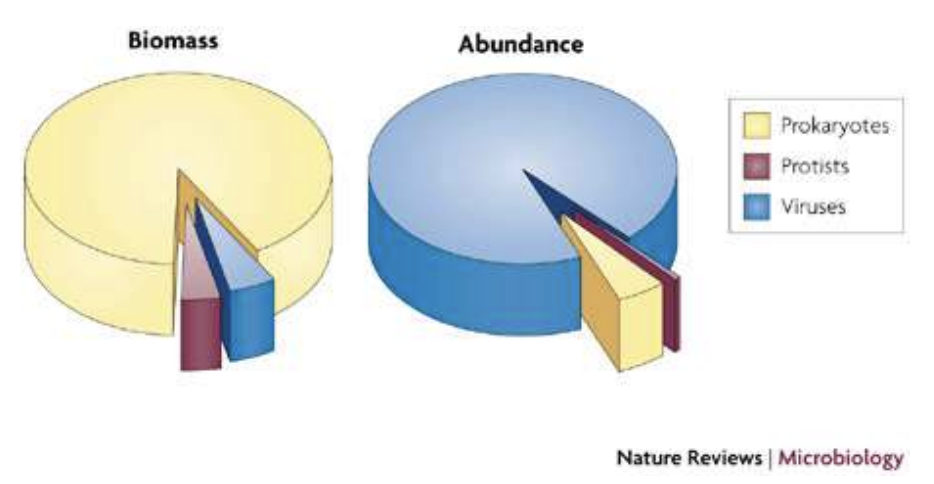
In contrast, while _ only represent less than 10% of nucleic-acid-containing particles in the ocean, they represent more than 90% of the biomass
Prokaryotes

T/F: There is no living organism not infected by viruses
TRUE
There are even viruses infecting other viruses, i.e., virophages
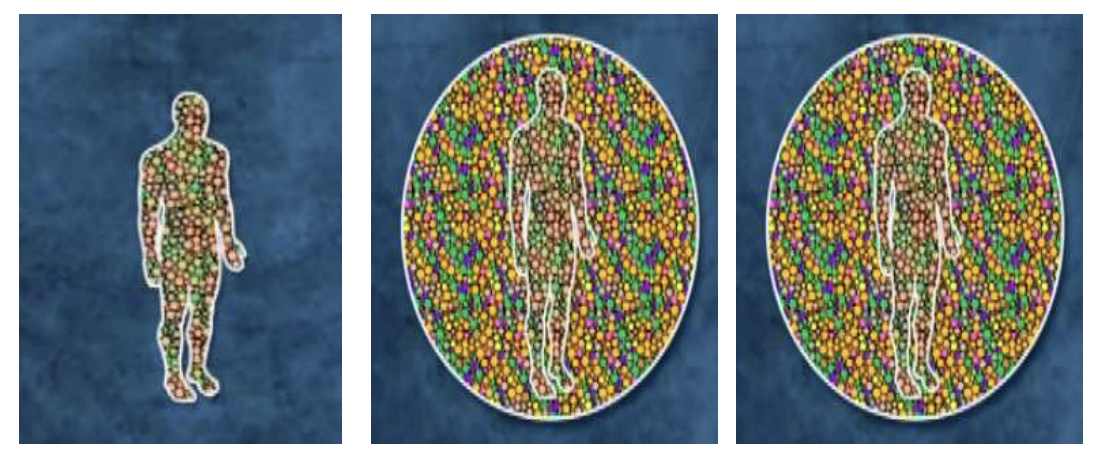
Describe human body in terms of cell composition
1 trillion human cells in our body
10 trillion bacterial cells
100 trillion viral particles, which make us
0.01% human, 0.1% bacterial, 99.89% viral
T/F: Viruses are by far the most abundant biological entities in the ocean, comprising 94% of the biomass
FALSE
Viruses are by far the most abundant biological entities in the ocean, comprising 94% of the nucleic-acid-containing particles, only ~5% of biomass because of their small size
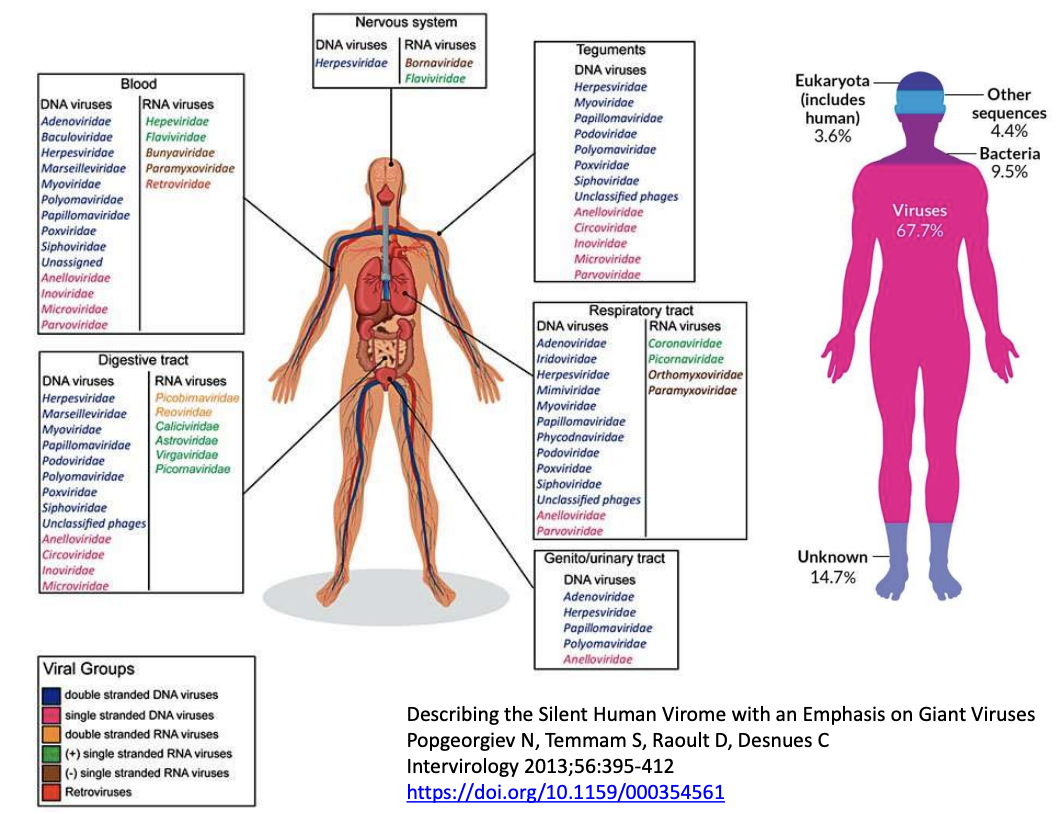
Describe human body in terms of genome composition
4% eukaryotic
10% bacterial
68% viral (virome)
15% unknown
4% other sequences
Explain the nucleotide sequence content of the human genome
Even in human genome, we carry fossils of viral DNA segments
Repeated sequences
Segmental duplications
Simple sequence repeats (SSRs)
Transposons
DNA-only transposon fossils ~42%
Nonfunctional DNA remnants that were once capable of moving but now are inactive
Retroviral-like elements
SINEs (Short Interspersed Nuclear Elements) 30%
Cannot encode proteins but propagate using enzymes produced by LINEs
LINEs (Long Interspersed Nuclear Elements) 20%
Can copy and insert themselves elsewhere in the genome
Unique sequences
Non-repetitive DNA (neither in introns or codons) 60%
Genes
Introns 98%
Protein-coding regions (exons) 100%
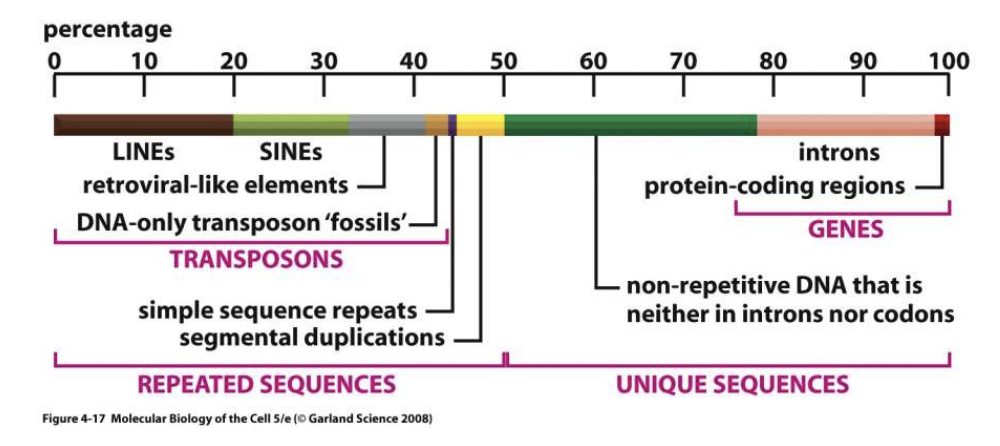
Viruses are becoming more widely recognized as _, with metagenomic studies suggesting that _
shuttles of genetic material
the billions of viruses on Earth harbor more genetic information than the rest of the living world combined

Explain Hershey-Chase experiment (1952) using bacteriophages
Hershey & Chase, using bacteriophages, established that DNA is the genetic material
Bacteriophages (bacteria-infecting viruses) have 2 components:
DNA inside
Protein coat outside
They labeled DNA with 32P (phosphorus) and protein coat with 35S (sulfur), then infected bacteria with bacteriophages
After infection, they blended and centrifuged mixture to separate viral particles from DNA
Results: They found the 32P (phosphorus) label inside bacterial cell, while 35S (sulfur) stayed outside, suggesting that DNA is the genetic material
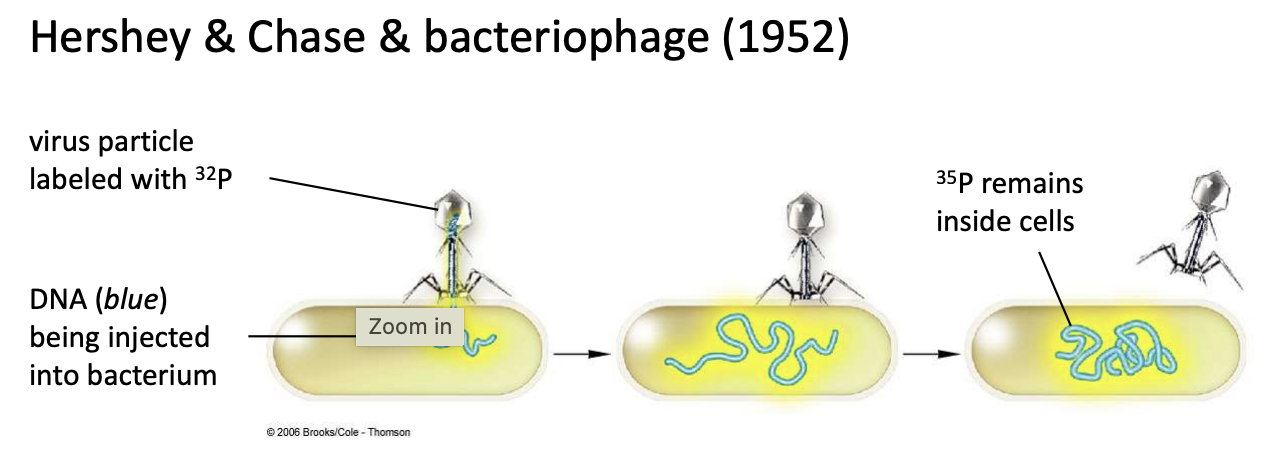
Enumerate major discoveries/breakthroughs we’ve had using viruses
Hershey-chase experiment using bacteriophages to establish DNA as the genetic material
Used viruses to study eukaryotic gene expression, specifically introns, exons, splicing discovery
Used viruses to study prokaryotic gene expression, transcription factors, roles of enhancers, 5’ cap, internal ribosomal elements
Enumerate 5 utility of viruses (elaborate on the first one)
Vectors for recombinant protein production; biopharmaceuticals
General steps to recombinant protein production
Harvest cells from a patient
In lab, alter virus to prevent it from reproducing
Then insert gene of interest into the altered virus
Mix altered virus + harvested patient cells, altering harvested patient cells in lab
Inject altered cells into patient’s body, so that altered cells produce the desired protein
Vectors for treatment of genetic disease
Source of enzymes, e.g., reverse transcriptase, RNA polymerases
Phage typing of bacteria
Pesticides (Baculovirus, Myxoma virus)
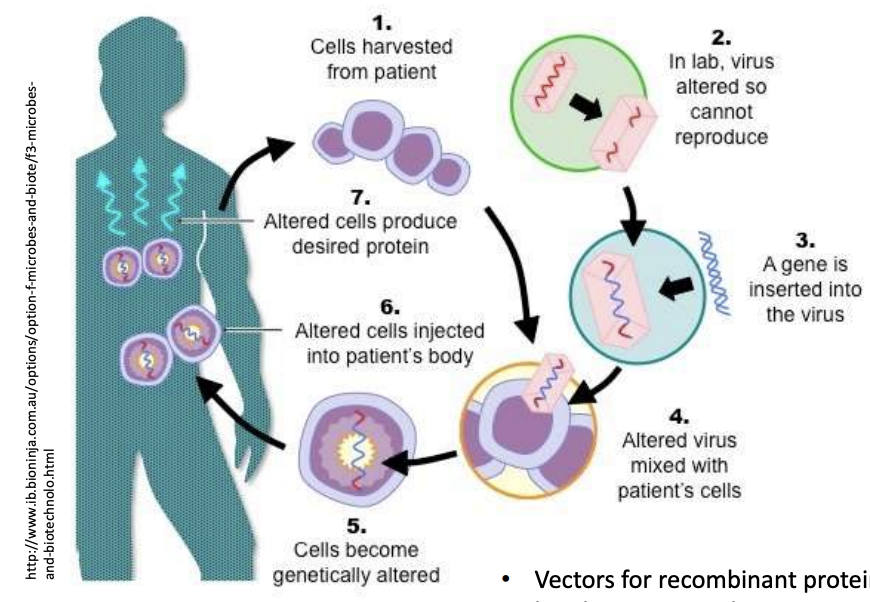
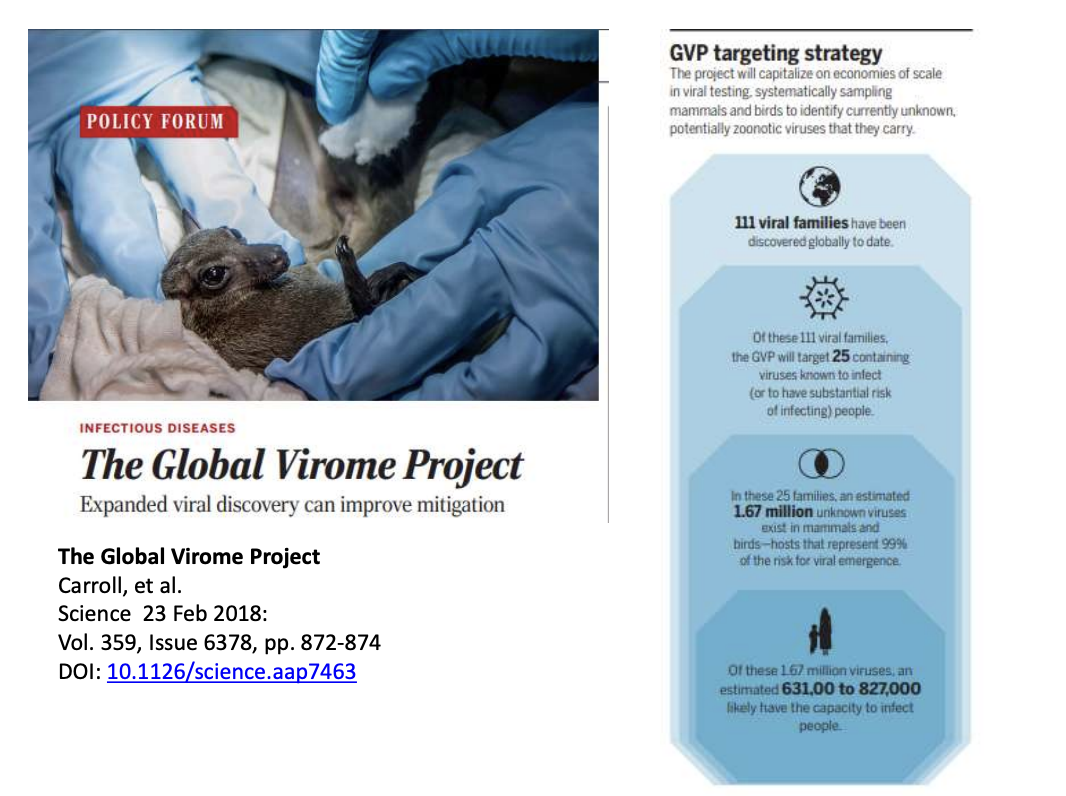
Describe the Global Virome Project and their targeting strategy
Global Virome Project (GVP) is an international initiative aiming to understand the diversity of viruses in the animal kingdom, particularly those with potential to cause pandemics
Its goal is to predict and prevent future viral outbreaks by studying viruses circulating in wildlife and their likelihood of spilling over into human populations
Targeting strategy
GVP will capitalize on economies of scale in viral testing, systematically sampling mammals and birds to identify currently unknown, potentially zoonotic viruses they carry
111 viral families have been discovered to date
Of 111, GVP plans to target 25 viral families containing viruses known to or have the substantial risk to infect people
Of 25 families, 1.67M unknown viruses exist in mammals and birds, which are hosts with 99% risk for viral emergence
Of 1.67M, an estimate of 600,000 - 800,000 likely have capacity to infect people

Site: 5-hectare land in New Clark City
Site development and construction of facilities to be financed by DOST
Project to be completed in 6 yrs
What’s inside: Administration building, lecture hall, manufacturing product building, human and animal virology lab, plant virology lab, animal isolation, BSL 3 and 4 lab building, plant cultivation area, dormitory, power station, sewage treatment plant
Virology Institute of the Philippines (VIP)
Explain why virus discovery is no longer just driven by disease
The advent of metagenomics using high throughput sequencing has revolutionized not only the rate of virus discovery but also the nature of the discoveries.
For example, vnd
viral ecology and etiology of human diseases are being characterized,
nonpathogenic viral commensals are ubiquitous, and
description of environmental viromes is making progress.
Ongoing projects in Virology Institute of the Philippines (VIP)
Detection of food- and waterborne bacterial pathogens using phage-based diagnostics
Combination therapy: Lytic bacteriophages and plant extracts against multi-drug resistant bacteria
Isolation and purification of Philippine common viruses with medical importance and pandemic potential for antigen-antibody studies
Enumerate and explain 3 significant people in microbiology and their contributions
Antonie Van Leeuwenhoek (1632 - 1723)
First to describe cells “animalcules” with microscope
Louis Pasteur (1822 - 1895)
Disproved spontaneous generation using swan-necked flask
Pasteurization to get rid of undesirable microbes in milk
Robert Koch (1843 - 1910)
Koch’s postulates for linking disease to microbes
Explain Koch’s postulates (1890)
The microorganism should be found in abundance in all organisms suffering from the disease but should not be found in healthy organisms
The microorganism should be isolated from the diseased organism and grown in pure culture
The cultured microorganism should cause the same disease when inoculated into a healthy organism
The microorganism should be re-isolated from the diseased experimental host and identified as identical to the original specific causative agent
*While Koch’s postulates were essential for defining many agents of disease, not all pathogenic viruses fulfilled these criteria
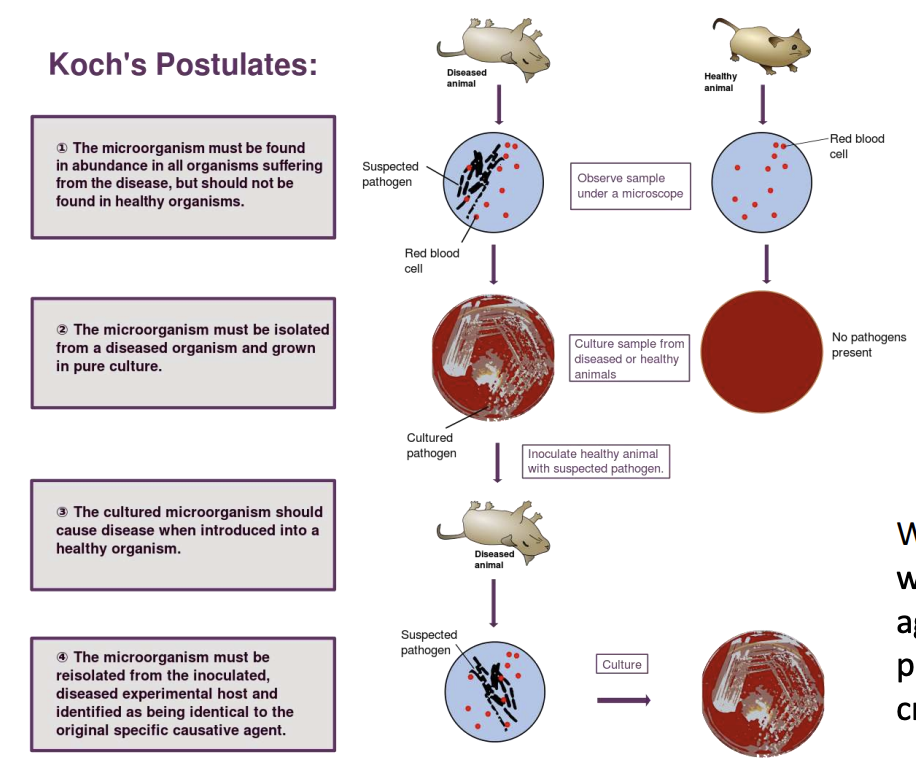
Explain how not all pathogenic viruses fulfill Koch’s postulate
The microorganism should be found in abundance in all organisms suffering from the disease but should not be found in healthy organisms
Not observed when HIV has already integrated its genome into host
Chicken pox virus can cause shingles when you’re older
The microorganism should be isolated from the diseased organism and grown in pure culture
Can’t be grown in pure culture, needs a host!
The cultured microorganism should cause the same disease when inoculated into a healthy organism
Not all the time
The microorganism should be re-isolated from the diseased experimental host and identified as identical to the original specific causative agent
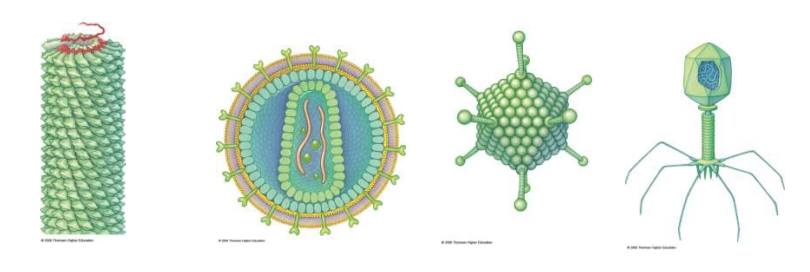
Common definition of virus
“Virus” acc to Louis Pasteur means
Obligate intracellular parasites
“Virus” = poison or venom
What was the first virus (and viral disease) identified? Explain.
Ivanovski & Beijerinck (1950s) identified “filterable infectious agents” that caused tobacco mosaic disease, now known as Tobacco Mosaic Virus (TMV)
How they discovered
Crushed the diseased tobacco leaf
Filtered it through a 0.22 um filter
Had 2 setups
Inoculated leaf w/ cell debris = leaf remained healthy
Inoculated w/ filtrate (whtvr that passed thru the filter) = leaf died but when cultured, nothing grew from filtrate bc viruses need host to live

3 other milestones in early history of virology
Loeffler and Frosch (1898) discovered the first animal-infecting viral disease → Foot and Mouth Disease
Reed (1901) discovered the first insect-borne viral disease → Yellow Fever Virus
Setup
In 1 room, they allowed insects to feed on soldier infected with YF and kept a group of soldiers on the next room
Opened the door, causing insects to infect those soldiers from another room, resulting in death of most from YF
Rous (1911) discovered that viruses contribute to formation of solid tumors or sarcoma
Obtained tumors from chicken’s breast muscle and broke those down into smaller chunks of tissue
Then ground up the tumor tissues with sand and filtered it through 0.22 um filter
Collected and inoculated filtrate to young chicken, which later on developed sarcoma

French scientists who studied bacteriophages (bacteria-infecting viruses)
Twort (1915) & d’Herelle (1917)
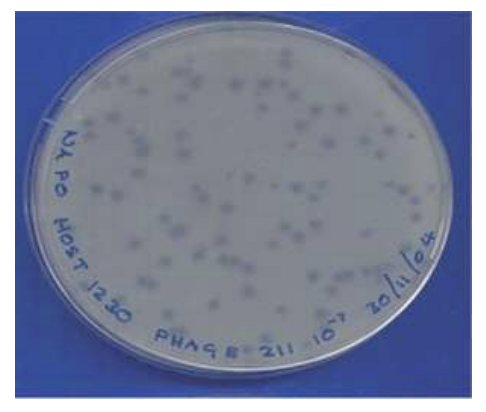
Explain how Twort and d’Herelle studied bacteriophages
Created bacterial lawn
Spread appropriate dilution of virus sample into lawn to enumerate viruses by counting the clearings called “plaques,” which represent 1 viral particle that replicated and when bacteria burst, new parasites infected neighboring cells
_ refers to inanimate vectors
Fomites
2 types of vectors
Living vectors (e.g., arthropods)
Fomites (non-living vectors)
Basic components of a cell vs. of a virus
Cell
DNA
Plasma membrane
Cytoplasm + ribosomes
Virus
Genetic material (DNA/RNA)
Protein coat (capsid)
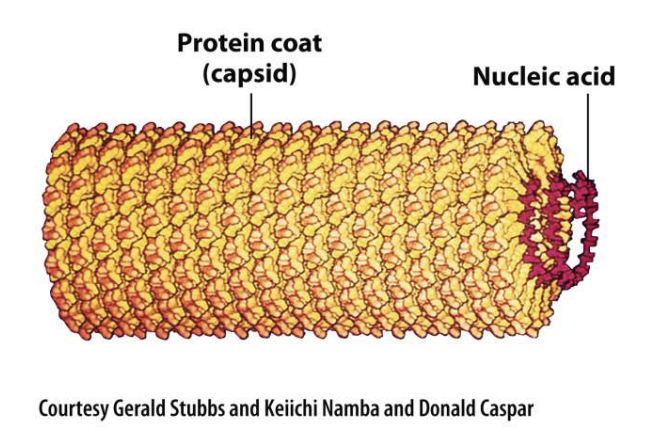
T/F: It is possible for infectious agents to just have nucleic acids or proteins
TRUE
T/F: All viruses are smaller than all known bacterial cells
FALSE
There are giant viruses larger than bacterial cells
_ represent 1 viral particle in bacterial lawn that replicated and when bacteria burts, its new parasites infected the neighboring bacterial cells
Plaques
_ is the first insect-borne viral disease discovered by Reed (1901)
Yellow fever virus

Who discovered that viruses can contribute to formation of solid tumors (sarcoma) in chicken?
Rous (1911)
_ is the first animal-infecting viral disease discovered by Loeffler and Frosch (1898)
Foot and mouth disease (FMD)
T/F: Humans carry exogenous retrovirus elements in their genome, including LINEs and SINEs
FALSE
Humans carry endogenous retrovirus elements in their genome, including LINEs and SINEs
T/F: Some viruses have envelope consisting of lipid bilayer derived from host cell, e.g., HIV, coronaviruses
TRUE
T/F: Herpesviruses are smaller than Polioviruses
FALSE
Herpesviruses are larger (200 nm) than Polioviruses (30 nm)
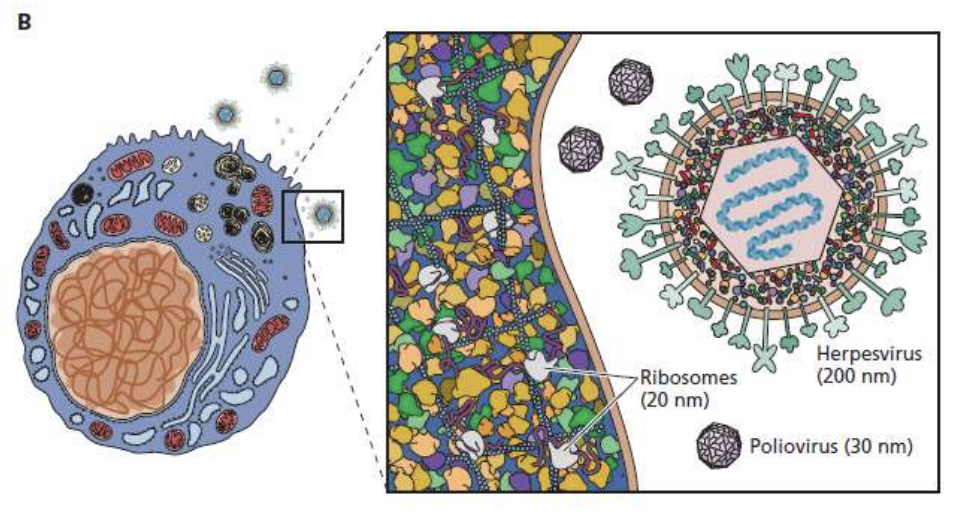
T/F: Virions are always present and detectable in the host cell
FALSE
It’s possible they have not been assembled yet
Virus vs. Virions
Virus = infectious particle that takes over host machinery; obligate intracellular parasites
Virions = detectable infectious particles outside the host cell; only a transport/delivery form
T/F: Virions can be considered a specific physical form of a virus designed for protection and transmission outside the host
TRUE
T/F: The term 'virus' refers exclusively to the infectious particle outside the host cell
FALSE
The term "virus" refers to the infectious entity in all stages, whether inside or outside the host cell. "Virion" specifically refers to the virus outside the host.
In 2003, giant viruses, also known as _, were discovered, e.g., Mimivirus
Nucleocytoplasmic large DNA viruses (NCLDV)
T/F: Giant viruses or nucleocytoplasmic large DNA viruses (NCLDV) have identified ribosomal genes
FALSE
Giant viruses or nucleocytoplasmic large DNA viruses (NCLDV) don’t have identified ribosomal genes
T/F: Size of E. coli genome in terms of base pair is smaller than that of Mimivirus
FALSE
Humans = 6,000,000,000 bp
Yeasts (fungi) = 10,600,000 bp
E. coli (bacteria) = 4,700,000 bp
Mimivirus (viruses) = 800,000 bp
MS2 (bacteriophage) = 3,200 bp
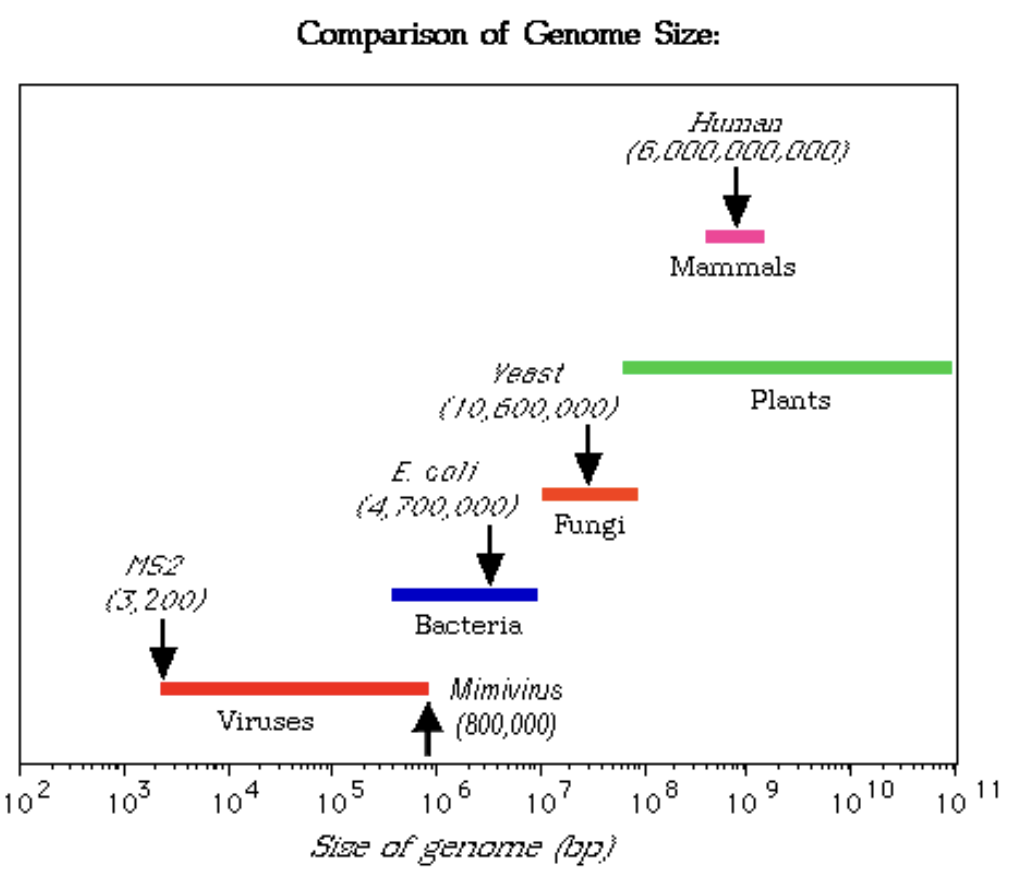
Explain 5 characteristics defining a virus
ocdpv
Viruses are infectious, obligate intracellular parasites
Viral genome comprises DNA or RNA
Viral genome directs the synthesis of viral components by cellular systems within an appropriate host cell
Infectious progeny virus particles called virions form via de novo self assembly from newly synthesized components
Progeny virion assembled during infection cycle is vehicle for transmission of viral genome to the next host cell or organism, where it’s disassembly initiates the next infectious cycle
_ directs synthesis of viral components by cellular systems within an appropriate host cell
Viral genome
Progeny virions are formed from _ using newly synthesized components
de novo self assembly
_ are vehicles for transmission of viral genome to the next host cell or organism, where its disassembly initiates the next infectious cycle
Progeny virion
Viruses are capable of _ when inside the host
grhme
Growth and reproduction
Response to stimuli
Homeostasis
Metabolism
Evolution
In 1935, Stanley proved that viruses are non-living because _
even after crystallizing them, the virus still maintained its biological properties and infected cells of the tobacco leaf

Explain virus life cycle
Extracellular phase
Virions are metabolically inert and do not reproduce outside host cell; have few enzymes but are not active
Intracellular phase
These then enter host cell, attaching and entering host cell, so whatever nucleic acid they have will be replicated, genes and structural proteins will be expressed, then assembled into virions, which exit then the cell
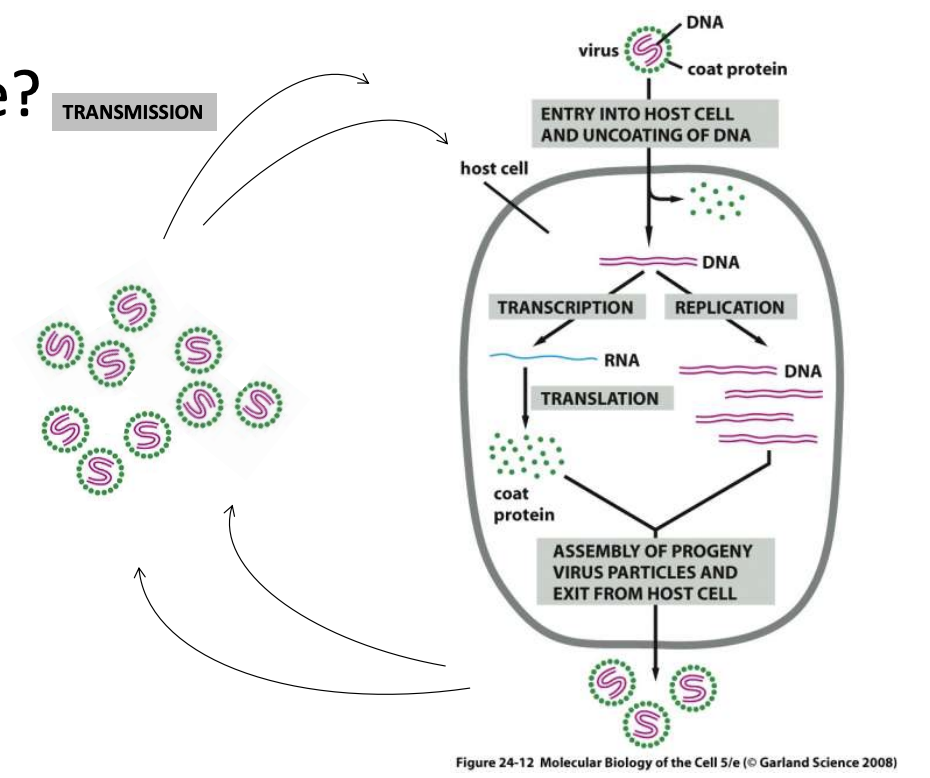
T/F: Despite viruses having 1 phase in their life cycle where they can be considered “living,” they are not reflected in the tree of life
TRUE
Bc the basis of the tree were genes encoding 16S rRNA and viruses do not have ribosomal elements
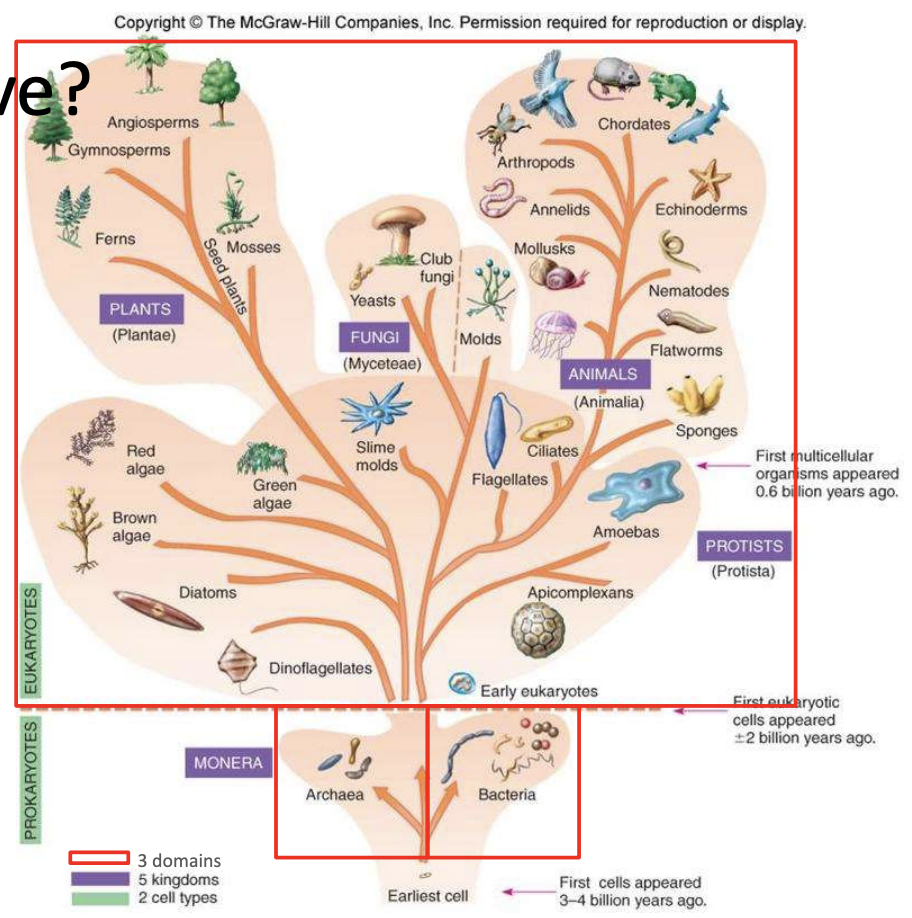
_ used 16S rRNA gene sequences to create Tree of Life (Domain Bacteria, Archaea, Eukarya)
Carl Woese
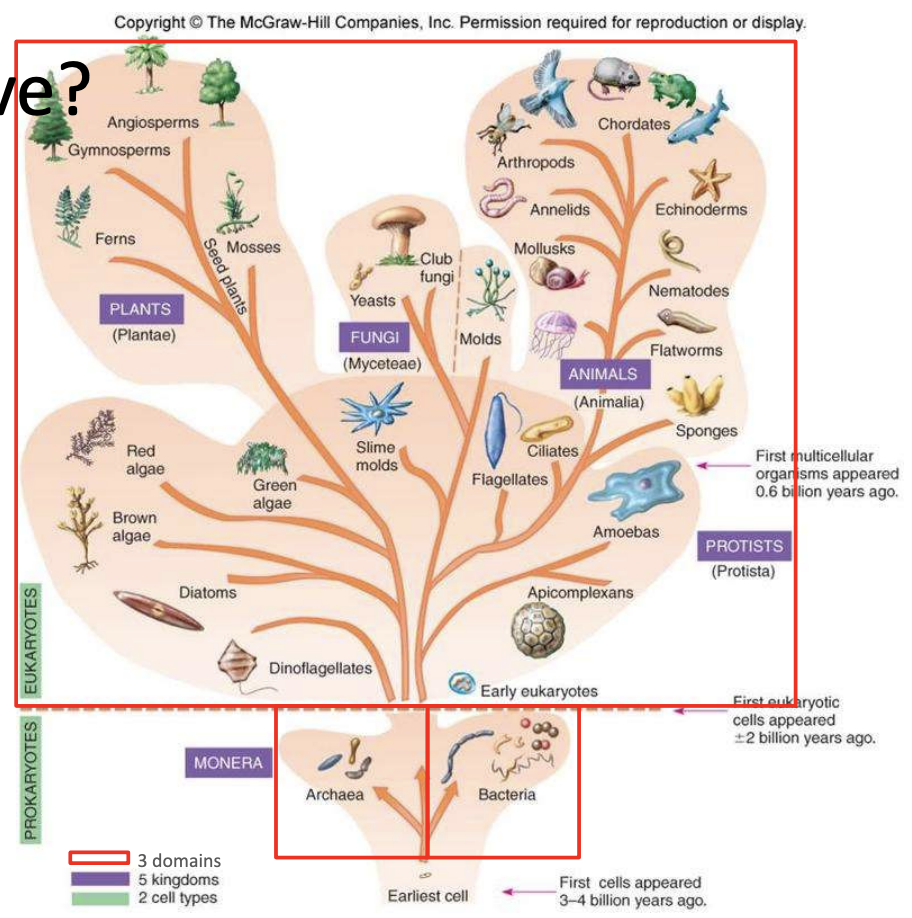
Where do eukaryotes get their 16S rRNA?
Mitochondria
How did they resolve the issue with (reconcile the phylogeny of) viruses not being included in the Tree of life, especially with some biologists arguing that they should be included in it?
All organisms should be divided into:
Ribosome-encoding organisms (REOs), which include Bacteria, Archaea, Eukarya, and;
Capsid-encoding organisms (CEOs), which are the viruses of BAE
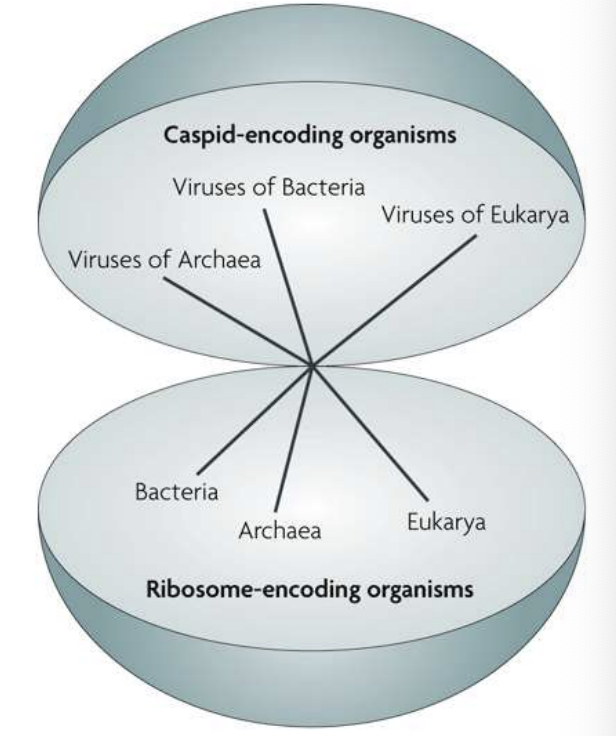
For _, through the REOs, CEOs division, giant viruses should take their place among microbes and, more importantly, among the living as the 4th branch of life
Whether viruses should be classified as a new domain, superkingdom, or TRUC (Things Resisting Uncomplete Classification) (which means “stuff” in French) is still up to debate
Didier Raoult

Raoult suggested the existence of a 4th domain for viruses, but the domains so far have been defined based on _, which are absent from these viruses
ribosomes

_ is the author of the study that promoted the use of hydroxychloroquine as cure for COVID-19 (didn’t undergo clinical trials; paper retracted last year)
Didier Raoult
T/F: Viruses are monophyletic in origin
FALSE
Viruses are polyphyletic in origin
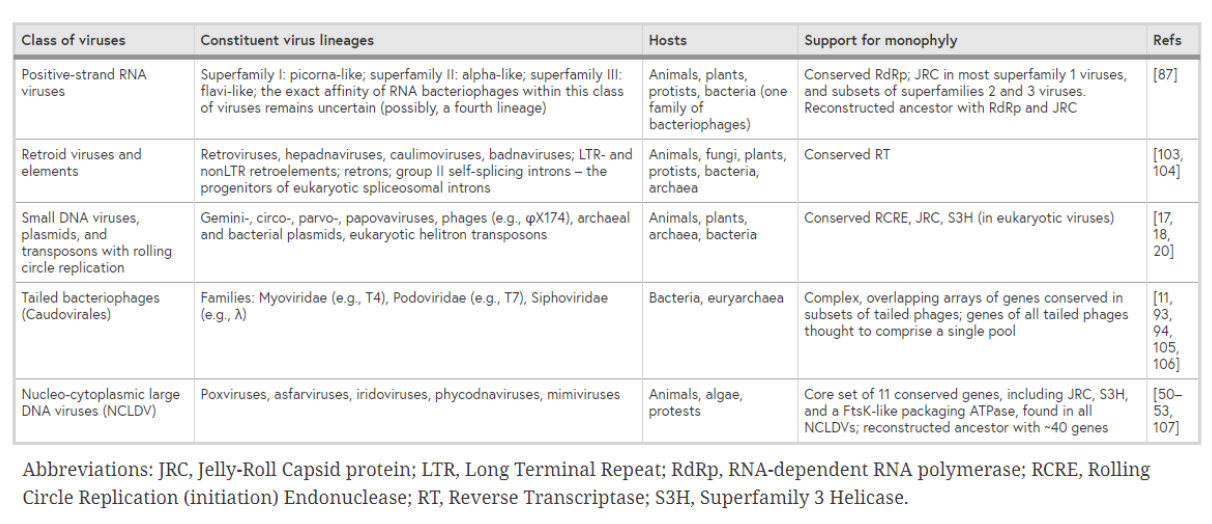
Explain 5 major monophyletic virus classes + support for monophyly
Classes prstn | Lineages | Hosts | Support for monophyly |
Positive strand RNA viruses | Superfamily I (picona-like), II (alpha), III (flavi), RNA bac | Animals, Plants, Protists, Bacteria appb | Conserved RdRp, JRC in most SI, SSII, SSII |
Retroid viruses & elements | Retroviruses, Hepadnaviruses | APPB + Fungi, Archaea | Conserved RT |
Small DNA viruses, plasmids, & transposons w/ rolling circle replication | Gemini-, Circo-, Parvo-, archaeal & bacterial plasmids, euk helitron transposons | Animals, Plants, Bacteria, Archaea | Conserved RCRE, JRC, S3H |
Tailed bacteriophages (Caudovirales) | Myo (T4), Podo (T7), Sipho (Lambda) | Bacteria, Euryarchaea | Complex, overlapping array of genes |
Nucleocytoplasmic large DNA viruses (NCLDVs) | Poxviruses, Mimiviruses, Asfarviruses, Iridoviruses | Animals, protists, algae | Core set of 11 conserved genes, including JRC, S3H |
Describe general timeline of life on Earth
4 bya = Prokaryotes (Bacteria, Archaea)
2 bya = Eukaryotes
<1 bya = Insects, mammals, humans
T/F: It is possible for viruses to have originated prior to cells (its hosts), after it, or across
TRUE